-
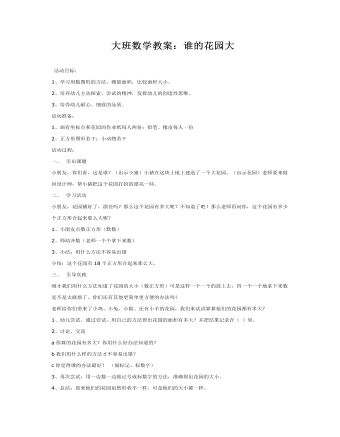
大班数学教案:谁的花园大
2、培养幼儿主动探索、尝试的精神,发挥幼儿的创造性思维。 3、培养幼儿耐心、细致的品质。 活动准备: 1、画有坐标点和花园的作业纸每人两份;铅笔、橡皮每人一份 2、正方形图形若干;小动物若干 活动过程: 一、 引出课题 小朋友,你们看,这是谁?(出示小猪)小猪在这块土地上建造了一个大花园,(出示花园)老师要来做回设计师,帮小猪把这个花园打扮的漂亮一些。 二、 学习活动 小朋友,花园铺好了,漂亮吗?那么这个花园有多大呢?不知道了吧!那么老师再问你,这个花园有多少个正方形合起来那么大呢? 1、小朋友点数正方形(默数) 2、师幼齐数(老师一个个拿下来数) 3、小结:用什么方法不容易出错 小结:这个花园有18个正方形合起来那么大。
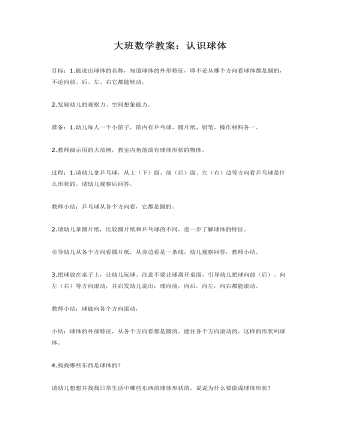
大班数学教案:认识球体
2.发展幼儿的观察力、空间想象能力。准备:1.幼儿每人一个小筐子,筐内有乒乓球、圆片纸、铅笔、操作材料各一。2.教师演示用的大范例,教室内角落放有球体形状的物体。过程:1.请幼儿拿乒乓球,从上(下)面、前(后)面、左(右)边等方向看乒乓球是什么形状的。请幼儿观察后回答。教师小结:乒乓球从各个方向看,它都是圆的。2.请幼儿拿圆片纸,比较圆片纸和乒乓球的不同,进一步了解球体的特征。

大班数学教案:编译密码
2.锻炼幼儿运用逆向思维的方式进行运算,培养幼儿的运算兴趣;3.让幼儿充分感受成功解决数学问题的乐趣。 活动准备教师准备:电话号码卡两张;l一10的数字卡;幼儿准备:熟悉自己家的电话号码;电话号码册、铅笔、橡皮等。 活动组织:1.导入活动师:昨天晚上,我接到从我们班转学的豪豪小朋友打来的电话,他说很想你们,那你们想不想他?如果想他,怎样和他联系?(让幼儿自由讨论,引出打电话的想法。)师:他家的电话号码是xxxxxxxx,(出示电话号码)我们来数数他家的电话号码是几位?(幼儿一起点数)他家电话号码的第几位数是几?
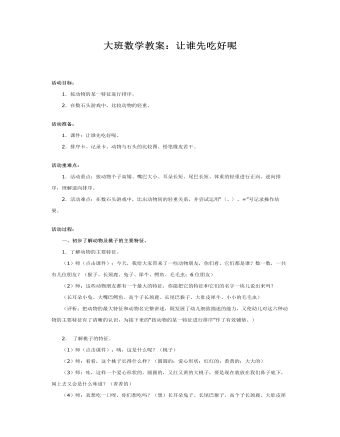
大班数学教案:让谁先吃好呢
活动准备:1.课件:让谁先吃好呢。2.排序卡、记录卡、动物与石头的比较图、铅笔橡皮若干。活动重难点:1.活动重点:按动物个子高矮、嘴巴大小、耳朵长短、尾巴长短、体重的轻重进行正向、逆向排序,理解逆向排序。2.活动难点:在数石头游戏中,比出动物间的轻重关系,并尝试运用“〈、〉、=”号记录操作结果。活动过程: 一、初步了解动物及桃子的主要特征。1.了解动物的主要特征。 (1)师(点击课件):今天,我给大家带来了一些动物朋友,你们看,它们都是谁?数一数,一共有几位朋友?(猴子、长颈鹿、兔子、犀牛、鳄鱼、毛毛虫;6位朋友) (2)师:这些动物朋友都有一个最大的特征,你能把它的特征和它们的名字一块儿说出来吗? (长耳朵小兔、大嘴巴鳄鱼、高个子长颈鹿、长尾巴猴子、大肚皮犀牛、小小的毛毛虫) (评析:把动物的最大特征和动物名完整讲述,既发展了幼儿细致描述的能力,又使幼儿对这六种动物的主要特征有了清晰的认识,为接下来的“按动物的某一特征进行排序”作了有效铺垫。)2.了解桃子的特征。 (1)师(点击课件):咦,这是什么呢?(桃子) (2)师:看看,这个桃子长得什么样?(圆圆的;爱心形状;红红的;黄黄的;大大的) (3)师:哇,这样一个爱心形状的、圆圆的,又红又黄的大桃子,要是现在就放在我们鼻子底下,闻上去又会是什么味道?(香香的) (4)师:真想吃一口呀,你们想吃吗?(想)长耳朵兔子、长尾巴猴子、高个子长颈鹿、大肚皮犀牛、大嘴巴鳄鱼、小小的毛毛虫和我们一样,看到这个桃子,馋得口水都快流出来了,都想先吃到这个大桃子。 (评析:对桃子形状、颜色、大小特征的讲述,以及对桃子气味的猜测,既“勾”起了幼儿品尝桃子的欲望,又“唤”起了他们对动物看到桃子后急切品尝心境的理解,适时、巧妙的引出了本次活动的一条暗藏线索“让谁先吃好呢?”。)二、按动物的某一特征排序。1.按动物高矮、大小、长短排序。 (1)按个子的高矮排序。A.师(点击课件):“按照个子的顺序吃怎么样?”长颈鹿把脖子挺得直直的,先说了一句。那就得先量量看,谁的个子最高了。毛毛虫说:“不能站在高的地方量,量的时候不能把尾巴算上”小兔说:“踮起脚来量也不行。”B.师(点击课件):瞧,他们每人都找了一棵大树开始量了起来。动物们和大树的什么比?(树干)C.师:它们一个个都紧贴着树干,认真的量着。小朋友,你们看出来了吗?谁最高?第二高是谁呢?第三高呢?接下来轮到谁?第五高?最矮的一个是谁呀?D.出示高矮排序图。E.讲述故事:“看见了吧?看见了吧?我的个子最高,所以得我先吃!”长颈鹿把脖子伸得长长的,刚要去咬那个又大又红的桃子。 (2)按嘴巴的大小排序。A.师(点击课件):“不行,这么大的桃子,当然得嘴巴最大的先吃了”鳄鱼张着一张大嘴,站了出来。到底谁的嘴巴最大?B.师(点击课件):“我的嘴巴大!”(犀牛声音)“谁说的!我的嘴巴才是最大的呢!”(鳄鱼声音)C.师:你们说,谁的嘴巴最大?(鳄鱼)E.讲述故事:“听见没,听见没有?我的嘴巴最大,当然是我先吃了!”鳄鱼使足了全身的劲儿,张大嘴巴,马上就要咬到这个又大又红的桃子了…… (3)按耳朵的长短排序。A.师(点击课件):“这么做不行!”蹦蹦跳跳的兔子竖着耳朵跑过来。B.师:欸,兔子会说什么呢?(谁耳朵长谁吃)C.师:那就是说得按什么顺序来吃桃子?(长短顺序)D.师:按什么的长短顺序,谁能完整的说一说?(按耳朵的长短顺序吃)E.师(点击课件):对,应该按照耳朵长短的顺序、谁的耳朵长谁先吃!那就比比,看看到底谁的耳朵最长吧。“看,还是我的耳朵最长吧!”小个子的兔子好不容易够到长颈鹿的脖子,说道。

大班数学教案:7的组成
2、通过讨论、分析,理解一个数分成两个部分,如一个不风增加1,另一个部分就要减少1。 活动准备 塑料小鸭学具人手42只。 活动过程 一、复习6的组成 玩“碰球游戏”,出现数咔,师问:这数是几?答“6”。师:今天玩碰游戏,教师与小朋友的数合起来是6。(例如),师:我的1球碰几球?答:你的1球碰5球)教师问,小朋友可集体回答,也可小组回答,也可个别回答。 二、集体尝试活动
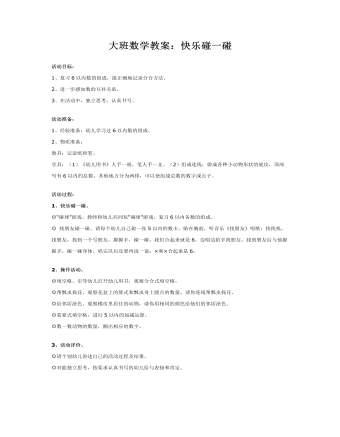
大班数学教案:快乐碰一碰
2、进一步感知数的互补关系。 3、在活动中,独立思考,认真书写。 活动准备: 1、经验准备:幼儿学习过6以内数的组成。 2、物质准备: 教具:记录纸和笔。 学具:(1)《幼儿用书》人手一册,笔人手一支。(2)组成连线:做成各种小动物形状的底纹,顶部写有6以内的总数,其他地方分为两排,可以使组成总数的数字或点子。 活动过程: 1、快乐碰一碰。 ◎“碰球”游戏。教师和幼儿共同玩“碰球”游戏,复习6以内各数的组成。 ◎找朋友碰一碰。请每个幼儿自己做一张5以内的数卡,贴在胸前,听音乐《找朋友》唱歌:找找找,找朋友,找到一个号朋友,握握手,碰一碰,我们合起来就是6。边唱边拍手找朋友,找到朋友后与他握握手,碰一碰身体。唱完以后还要再说一说:×和×合起来是6。
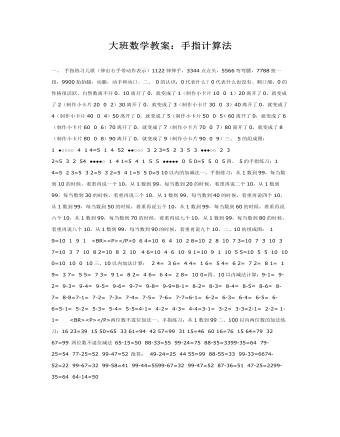
大班数学教案:手指计算法
一、手指练习儿歌(伸出右手带动作表示)1122伸伸手,3344点点头,5566弯弯腰,7788扭一扭,9900抬抬腿,动腿,动手和动口。二、 0的认识:0代表什么?0代表什么也没有。顺口溜:0的性格很活跃,自然数离不开0。10离开了0,就变成了1(制作小卡片10 0 1)20离开了0,就变成了2(制作小卡片20 0 2)30离开了0,就变成了3(制作小卡片30 0 3)40离开了0,就变成了4(制作小卡片40 0 4)50离开了0,就变成了5(制作小卡片50 0 5)60离开了0,就变成了6(制作小卡片60 0 6)70离开了0,就变成了7(制作小卡片70 0 7)80离开了0,就变成了8(制作小卡片80 0 8)90离开了0,就变成了9(制作小卡片90 0 9)三、 5的组成图:1 ●○○○○ 4 14=5 1 4 52 ●●○○○ 3 23=5 2 3 5 3 ●●●○○ 2 32=5 3 2 54 ●●●●○ 1 41=5 4 1 5 5 ●●●●● 0 50=5 5 0 5
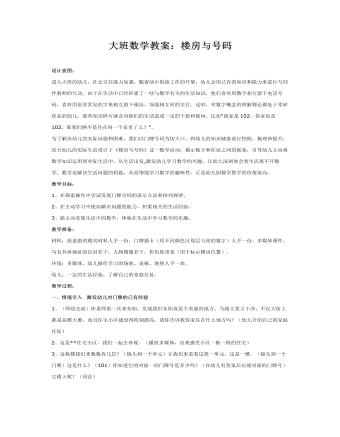
大班数学教案:楼房与号码
为了解决幼儿的实际问题和困难,我们以门牌号码为切入口,将幼儿的知识储备进行挖掘、梳理和提升,结合幼儿的实际生活设计了《楼房与号码》这一数学活动,揭示数字和住址之间的联系,引导幼儿主动将数学知识运用到实际生活中。从生活出发,激发幼儿学习数学的兴趣,让幼儿深刻体会到生活离不开数学,数学是解决生活问题的钥匙,从而增强学习数学的趣味性,正是幼儿园数学教学的价值取向。教学目标:1、在探索操作中尝试发现门牌号码的表示方法和排列规律。2、在主动学习中提高解决问题的能力,积累相关的生活经验。3、能主动发现生活中的数学,体验在生活中学习数学的乐趣。教学准备:材料:纸盒做的楼房材料人手一份,门牌插卡(用不同颜色区别层与间的数字)人手一份,多媒体课件,写有具体地址的信封若干,人物图像若干,彩色胶带卷(用于标示楼房位置)。环境:多媒体、幼儿操作学习的场地、桌椅、地垫人手一块。幼儿:一定的生活经验,了解自己的家庭住址。
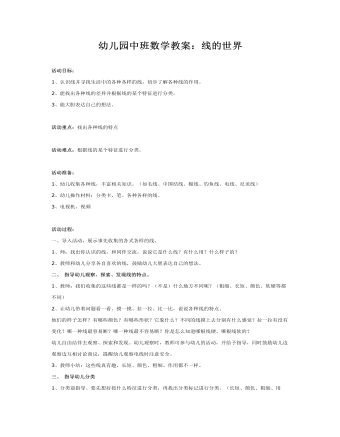
中班数学教案:线的世界
活动重点:找出各种线的特点 活动难点:根据线的某个特征进行分类。 活动准备:1、幼儿收集各种线,丰富相关知识。(如毛线、中国结线、棉线、钓鱼线、电线、尼龙线)2、幼儿操作材料:分类卡、笔、各种各样的线。3、电视机、视频 活动过程:一、导入活动,展示事先收集的各式各样的线。1、师:找出你认识的线,和同伴交流,说说它是什么线?有什么用?什么样子的?

中班数学教案:会变的图形
教学准备: 正方形纸、小刀。 教学过程: (一)变魔术 让幼儿猜想正方形能不能变成三角形、小正方形、长方形。然后将纸折叠,剪开变为各种图形。 将剪开的图形再拼成正方形。
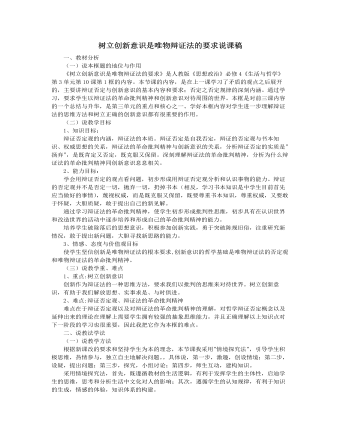
人教版高中政治必修4树立创新意识是唯物辩证法的要求说课稿(一)
(二)说学法指导把“学习的主动权还给学生”,倡导“自主、合作、探究”的学习方式,因而,我在教学过程中特别重视创造学生自主参与,合作交流的机会,充分利用学生已获得的生活体验,通过相关现象的再现,激发学生主动参与,积极思考,分析现象背后的哲学理论依据,帮助学生树立批判精神和创新意识,从而增强教学效果,让学生在自己思维的活跃中领会本节课的重点难点。(三)说教学手段:我运用多媒体辅助教学,展示富有感染力的各种现象和场景,营造一个形象生动的课堂气氛。三、说教学过程教学过程坚持"情境探究法",分为"导入新课——推进新课——走进生活"三个层次,环环相扣,逐步推进,帮助学生完成由感性认识到理性认识的飞跃。下面我重点简述一下对教学过程的设计。

人教版高中政治必修4树立创新意识是唯物辩证法的要求说课稿(二)
一、教材分析(一)说本框题的地位与作用《树立创新意识是唯物辩证法的要求》是人教版教材高二《生活与哲学》第三单元第十课的第一框题,该部分的内容实质上是在阐述辩证法的革命批判精神和否定之否定规律。是第三单元思想方法与创新意识》的重点和核心之一。学好这部分的知识对于学生进一步理解辩证法的思维方法,树立创新意识起着重要的作用。(二)说教学目标根据课程标准和课改精神,在教学中确定如下三维目标:1、知识目标:辩证否定观的内涵,辩证法的本质。辩证否定是自我否定,辩证否定观与书本知识和权威思想的关系,辩证法的革命批判精神与创新意识的关系,分析辩证否定的实质是"扬弃",是既肯定又否定;既克服又保留。深刻理解辩证法的革命批判精神,分析为什么辩证法的革命批判精神同创新意识息息相关。
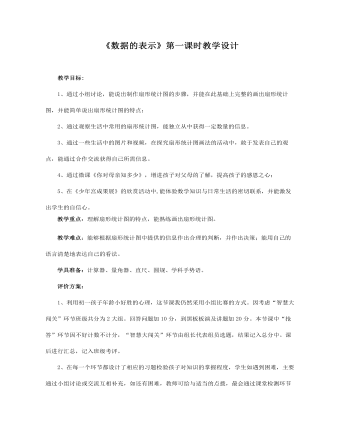
数据的收集与整理 3 数据的表示教案教学设计
创设情境,导入新课:你对母亲知多少师问1:我们5月份刚过了一个重要的节日,你知道是什么吗?----母亲节。师问2:那你知道妈妈的生日吗?(举手示意),每个妈妈都知道自己孩子的生日,请不知道的同学回家了解一下,多关心一下自己的父母。师问3:那你知道妈妈最爱吃的菜吗?你可以选择知道、不知道或者是没有爱吃的(拖动白板上相对应的表情符号)。请大家用不同的手势表示出来。我找3名同学统计各组的数据,写在黑板上(随机找3名学生数人数)。下面我来随机采访一下:你妈妈最喜欢吃的菜是什么?(教师随机采访,结合营养搭配和感恩教育)

新人教版高中英语必修3Unit 1 Festivals and Celebrations教学设计二
1. Ss look at the picture and scan the passage to understand the main idea while teacher is giving the following questions to inspire Ss to think.*Where are those people?*What are they doing?*Why are they so excited?2. Ss complete the passage with the appropriate -ing form. Then discuss and check the answers with class.Answers: boring, interesting, taking, exciting, amazing3. The teacher raises questions for the students to discuss and encourages them to express their opinions.*Do you like La Tomatina? Why or why not?4. Each group representative reports the discussion result, the teacher gives feedback and the evaluation.Step 6 PracticeActivity 41. Ss complete the Ex 2 in Using structures.2. Check the answers after finishing the exercises.①The dragon boat races are the most exciting part of the Dragon Boat Festival.② The children were excited to go Easter egg hunting.③What an amazing performance! This is the best music festival I have ever been to.④We were amazed by her funny-looking hat.⑤His inspiring speech at the conference won the admiration/ favour of the audience.⑥This is a challenging game to test your memory and observation capabilities. 3. T asks Ss to finish Ex 3 and 4 in Using structures by themselves, then check the answers with class.Step 6 Homework1. Understand and master the functions and usage of the -ing form;2. Finish the other exercises in Using structures.1、通过本节内容学习,学生是否理解和掌握动词-ing形式作定语和表语的功能和意义;2、通过本节内容学习,学生能否在理解文段内容的基础上,根据上下文语境和表达逻辑,能正确运用动词-ing形式描述节日庆典。3、通过本节内容学习,学生是否归纳和积累用于表达情绪的相关词汇。

新人教版高中英语必修3Unit 1 Festivals and Celebrations教学设计一
本板块的活动主题是“谈论节日活动”(Talk about festival activities),主要是从贴近学生日常生活的角度来切入“节日”主题。学生会听到发生在三个国家不同节日场景下的简短对话,对话中的人们正在参与或将要亲历不同的庆祝活动。随着全球化的进程加速,国际交流日益频繁,无论是国人走出国门还是外国友人访问中国,都已成为司空见惯的事情。因此,该板块所选取的三个典型节日场景都是属于跨文化交际语境,不仅每组对话中的人物来自不同的文化背景,对话者的身份和关系也不尽相同。1. Master the new words related to holiday: the lantern, Carnival, costume, dress(sb)up, march, congratulation, congratulate, riddle, ceremony, samba, make - up, after all. 2. To understand the origin of major world festivals and the activities held to celebrate them and the significance of these activities;3. Improve listening comprehension and oral expression of the topic by listening and talking about traditional festivals around the world;4. Improve my understanding of the topic by watching pictures and videos about different traditional festivals around the world;5. Review the common assimilation phenomenon in English phonetics, can distinguish the assimilated phonemes in the natural language flow, and consciously use the assimilation skill in oral expression. Importance:1. Guide students to pay attention to the attitude of the speaker in the process of listening, and identify the relationship between the characters;2. Inspire students to use topic words to describe the festival activities based on their background knowledge. Difficulties:In the process of listening to the correct understanding of the speaker's attitude, accurately identify the relationship between the characters.

新人教版高中英语必修3Unit 2 Morals and Virtues教学设计二
Activity 41. Students complete the task of activity 4, then teachers and students check the answers. 2. The teacher organized the students to work together and asked them to use the tables and mind maps sorted out before to retold the important choices in Lin Qiaozhi's life and their resultsStep 5 Language points1. The teacher asks the students to read the text carefully, find out the core words and long and difficult sentences in the text and draw lines, understand the use of vocabulary, and analyze the structure of long and difficult sentences. 2. The teacher explains and summarizes the usage of core vocabulary and asks the students to take notes. 3. The teacher analyzes and explains the long and difficult sentences that the students don't understand, so that the students can understand them better. Step 6 Homework1. Read the text again, in-depth understanding of the text; 2. Master the use of core vocabulary and understand the long and difficult sentences. 3. Complete relevant exercises in the guide plan. 1、通过本节内容学习,学生是否理解和掌握阅读文本中的新词汇的意义与用法;2、通过本节内容学习,学生能否结合文本特点总结林巧稚的人生原则和人格品质特征;3、通过本节内容学习,学生能否针对人生抉择发表自己的看法;能否全面地、客观地、理性地看待问题,进而对道德和人性有更加深入的思考和理解。

新人教版高中英语必修3Unit 1 Festivals and Celebrations教学设计三
*wide range of origins(= a great number of different origins, many kinds of origins)*It featured a parade and a great feast with music, dancing, and sports. (=A parade and a great feast with music, dancing, and sports were included as important parts of the Egyptian harvest festival.)*.. some traditions may fade away and others may be established.(= Some traditions may disappear gradually, while other new traditions may come into being.)Step 6 Practice(1) Listen and follow the tape.The teacher may remind the students to pay attention to the meaning and usage of the black words in the context, so as to prepare for the completion of the blanks in activity 5 and vocabulary exercises in the exercise book.(2) Students complete the text of activity 5 by themselves.The teacher needs to remind the students to fill in the blanks with the correct form of the vocabulary they have learned in the text.Students exchange their answers with their partners, and then teachers and students check their answers.(3)Finish the Ex in Activity 5 of students’ book.Step 7 Homework1. Read the text again, in-depth understanding of the text;2. Discuss the origin of festivals, the historical changes of related customs, the influence of commercial society on festivals and the connotation and essential meaning of festivals.3. Complete relevant exercises in the guide plan.1、通过本节内容学习,学生是否理解和掌握阅读文本中的新词汇的意义与用法;2、通过本节内容学习,学生能否结合文本特点快速而准确地找到主题句;3、通过本节内容学习,学生能否理清论说文的语篇结构和文本逻辑,了解节日风俗发展与变迁,感悟节日的内涵与意义。

新人教版高中英语必修3Unit 2 Morals and Virtues教学设计三
The joke set her crying.这个玩笑使她哭起来。Step 5 ReadingActivity 31. Students read the small text in activity 3. The teacher provides several small questions to check whether students understand the content of the text and the ideographic function of the -ing form in the text.*Where are those people?*Why did Dr Bethune come to China?*How did he help the Chinese people during the war?*What did Chairman Mao Zedong say about him?2. Ss try to rewrite some sentences using the -ing form. Then check the answers. When checking the answers, the teacher can ask different students to read the rewritten sentences and give comments.Answers:1. he became very interested in medicine, deciding to become a doctor.2. …after hearing that many people were dying in the war.3. Helping to organise hospitals, he taught doctors and nurses, and showed people how to give first aid./ He helped to organise hospitals, teaching doctors and nurses, and showing people how to give first aid.4. …praising Dr Bethune as a hero to be remembered in China.Step 6 PracticeActivity 4Students complete grammar activities 2 and 3 on page 69 of the workbook.Step 6 Homework1. Understand and master the functions and usage of the -ing form;2. Finish the other exercises in Using structures.1、通过本节内容学习,学生是否理解和掌握动词-ing形式作宾语补足语语和状语语的功能和意义;2、通过本节内容学习,学生能否正确使用动词-ing形式描述人物的行为、动作及其经历;3、通过本节内容学习,学生能否独立完成练习册和导学案中的相关练习。

新人教版高中英语必修3Unit 2 Morals and Virtues教学设计四
3.Teachers ask different groups to report the answers to the questions and ask them to try different sentence patterns.The teacher added some sentence patterns for students to refer to when writing.Step 4 Writing taskActivity 51.Write the first draft.Students first review the evaluation criteria in activity 5, and then independently complete the draft according to the outline of activity 4, the answers to the questions listed in the group discussion and report, and the reference sentence pattern.2.Change partners.The teacher guides the students to evaluate their partner's composition according to the checklist of activity 5 and proposes Suggestions for modification.3.Finalize the draft.Based on the peer evaluation, students revise their own compositions and determine the final draft.Finally, through group recommendation, the teacher selects excellent compositions for projection display or reading aloud in class, and gives comments and Suggestions.Step 5 Showing writingActivity 5T call some Ss to share their writing.Step 6 Homework1. Read the passage in this section to better understand the passage.2. Carefully understand the hierarchical structure of the article, and deeply understand the plot of the story according to the causes, process and results;3. Independently complete the relevant exercises in the guide plan.1、通过本节内容学习,学生是否理解和掌握阅读文本中的新词汇的意义与用法;2、通过本节内容学习,学生能否通过人物言行的对比分析道德故事的深层内涵;3、通过本节内容学习,学生能否根据故事的起因、经过和结果来深入理解故事的情节,从而了解文章的层次结构;4、结合现实生活案例发表自己的见解和看法,写一篇观点明确、层次分明的故事评论。

新人教版高中英语必修3Unit 2 Morals and virtues教学设计一
(2) students are divided into groups according to the requirements of activity 3. Each student shares a story of personal experience or hearing-witnessing kindness, and then selects the most touching story in the group and shares it with the whole class. Before the students share the story, the teacher can instruct them to use the words and sentence patterns in the box to express. For example, the words in the box can be classified:Time order: first of all, then, after that, later, finally logical relationship :so, however, although, butTeachers can also appropriately add some transitional language to enrich students' expression:Afterwards, afterwards, at last, in the end, eventuallySpatial order: next to, far from, on the left, in front ofOtherwise, nevertheless, as a result, therefore, furthermore, in addition, as well asSummary: in a word, in short, on the whole, to sum up, in briefStep 8 Homework1. Understand the definition of "moral dilemma" and establish a correct moral view;2. Accumulate vocabulary about attitudes and emotions in listening texts and use them to express your own views;3. Complete relevant exercises in the guide plan.1、通过本节内容学习,学生能否理解理解“道德困境”的定义;2、通过本节内容学习,学生能否通过说话人所表达的内容、说话的语气、语调等来判断其态度和情绪;3、通过本节内容学习,学生能否针对具体的道德困境发表自己的看法和见解,能否掌握听力理训练中的听力策略。

